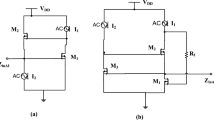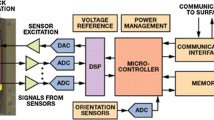Abstract
This paper develops an integrated concept of a relaxation oscillator to increase system frequency stability and to provide anti-noise signals at a nominal frequency of 8.2 MHz using 2 swing-boosting and self-threshold tracking loop methods. In this case, based on the design of a low-power, high-speed CMOS, the proposed relaxation oscillator is provided, which develops high-speed at low power under various operating conditions. To reduce the dependence of the output voltage on the system temperature, considering self-threshold-tracking loop technique, the transient voltage signals from inverter-based comparator devices, the transient voltage signals from inverter-based comparator devices are matched to the corresponding nominal value of the reference voltage, taking into account the self-threshold tracking loop technique. In this way, the proposed self-threshold tracking loop technique compensates for the existing time delay that ensures the required power consumption of the power comparator. The proposed scheme procedure is provided for the design of the methodology considering a 0.18 μm CMOS. Regarding the design processes, an Allan noise variation of 1.56 ppm with − 109 dBc/Hz phase-based noises with an offset frequency of 100 kHz is provided, which develops a jitter period of 7.66 psrms period through the design process. In this case, the corresponding evaluations yield 160.8 dBc/Hz with 5.6 kHz/nW power comparison efficiency, using only 46.3 μW as power consumption. In this respect, the proposed compensation scheme provides a sensitivity of 0.9%/0.1 V, which is very low compared to other conventional loops. According to the proposed relaxation oscillator scheme, there is an internal temperature of 123 ppm/°C, which is evaluated by − 20–100 °C without considering a modification procedure.





















Similar content being viewed by others
References
Iguchi, S., Sakurai, T., & Takamiya, M. (2017). A low-power CMOS crystal oscillator using a stacked-amplifier architecture. IEEE Journal of Solid-State Circuits, 52(11), 3006–3017.
Stegner, J., Stehr, U., Tu, C., Lee, J. E.-Y., Hein, M. A. (2017). Very-low phase noise RF-MEMS reference oscillator using AlN-on-Si resonators achieved by accurate co-simulation. In IEEE MTT-S Int. Microw. Symp. Dig., Honolulu, HI, USA, Jun. 2017, pp. 1303–1306.
FanoriLiscidiniCastello, L. A. R. (2010). Capacitive degeneration in LC-tank oscillator for DCO fine-frequency tuning. IEEE Journal of Solid-State Circuits, 45(12), 2737–2745.
Soltanian, B., & Kinget, P. R. (2006). Tail current-shaping to improve phase noise in LC voltage-controlled oscillators. IEEE Journal of Solid-State Circuits, 41(8), 1792–1802.
Ranjbar, S., Aghamohammadi, M. R., & Haghjoo, F. (2018). A new scheme of WADC for damping inter-area oscillation based on CART technique and Thevenine impedance. International Journal of Electrical Power & Energy Systems, 94, 339–353.
Chen, Y., Babaie, M., Staszewski, R. B. (2017). A 350-mV 2.4-GHz quadrature oscillator with nearly instantaneous start-up using series LC tanks. In Proceedings IEEE Asian Solid-State Circuits Conference (A-SSCC), Seoul, South Korea, pp. 104–108.
Sepehrirad, I., Ebrahimi, R., Alibeiki, E., & Ranjbar, S. (2020). Intelligent differential protection scheme for controlled islanding of microgrids based on decision tree technique. Journal of Control, Automation and Electrical Systems. https://doi.org/10.1007/s40313-020-00588-7
Kuo, W.-M.L., Cressler, J. D., Chen, Y. J. E., & Joseph, A. J. (2005). An inductor less Ka-band SiGe HBT ring oscillator. IEEE Microwave Wireless Components Letters, 15(10), 682–684.
Lee, J., George, A., Je, M. (2016). A 1.4 V 10.5 MHz swing-boosted differential relaxation oscillator with 162.1 dBc/Hz FOM and 9.86 psrms period jitter in 0.18 μm CMOS. In IEEE ISSCC Dig. Tech. Papers, San Francisco, CA, USA, Jan. /Feb. 2016, pp. 106–108.
Amraee, T., & Ranjbar, S. (2013). Transient instability prediction using decision tree technique. IEEE Transactions on Power Systems, 28(3), 3028–3037.
MasoudRadmehrRanjbar, M. J. S. (2020). "Adaptive wide area damping controller for damping inter-area oscillations considering high penetration of wind farms. International Transactions on Electrical Energy Systems. https://doi.org/10.1002/2050-7038.12392
Zhu, J., Mahalley, M., Shu, G., Choi, W. S., Nandwana. RK., Elkholy, A., Sahoo, B., Hanumolu, PK. (2017). A 45–75 MHz 197–452 μW oscillator with 164.6 dB FoM and 2.3 psrms period jitter in 65 nm CMOS. In Proc. IEEE Custom Integrated Circuits Conference (CICC), Austin, TX, USA, Apr. /May 2017, pp. 1–4.
Hsiao, K.-J. (2012). “A 32.4 ppm/°C 3.2–1.6 V self-chopped relaxation oscillator with adaptive supply generation,” in Proc. Symp. VLSI Circuits (VLSIC), Honolulu, HI, USA pp. 14–15.
Paidimarri, A., Griffith, D., Wang, A., Burra, G., & Chandrakasan, A. P. (2016). An RC oscillator with comparator offset cancellation. IEEE Journal of Solid-State Circuits, 51(8), 1866–1877.
Lee, Y., Giridhar, B., Foo, Z., Sylvester, D., Blaauw, D. (2011). A 660 pW multi-stage temperature-compensated timer for ultra-low-power wireless sensor node synchronization. IEEE ISSCC Dig. Tech. Papers, San Francisco, CA, USA pp. 46–48.
Ranjbar, S., Aghamohammadi M. R., Haghjoo, F. (2017) Damping inter- area oscillation in power systems using local psss based on global control signals. Tabriz Journal of Electrical Engineering (TJEE), 47(3).
Tokunaga, Y., Sakiyama, S., Dosho, S. (2010) An over 20,000 quality factor on-chip relaxation oscillator using power averaging feedback with a chopped amplifier. In Proc. Symp. VLSI Circuits. Honolulu, HI, USA pp. 111–112.
Shen, L., Lu, N., & Sun, N. (2018). A 1-V 0.25-μW inverter stacking amplifier with 1.07 noise efficiency factor. IEEE Journal of Solid-State Circuits, 53(3), 896–905.
Tsubaki, K., Hirose, T., Kuroki, N., Numa, M. (2013) A 32.55-kHz, 472-nW, 120 ppm/°C, fully on-chip, variation tolerant CMOS relaxation oscillator for a real-time clock application. In Proc. ESSCIRC (ESSCIRC), Bucharest, Romania pp. 315–318.
Tokairin, T., Nose, K., Takeda, K., Noguchi, K., Maeda, T., Kawai, K., Mizuno, M. (2012). A 280nW, 100kHz, 1-cycle start-up time, on-chip CMOS relaxation oscillator employing a feedforward period control scheme. In2012 Symposium on VLSI Circuits (VLSIC) pp. 16–17.
Babayan-Mashhadi, S., & Lotfi, R. (2014). Analysis and design of a low-voltage low-power double-tail comparator. IEEE Transactions on Very Large Scale Integration Systems, 22(2), 343–352.
Huang, S., Diao, S., & Lin, F. (2016). An energy-efficient high-speed CMOS hybrid comparator with reduced delay time in 40-nm CMOS process. Analog integrated circuits and signal processing, 89(1), 231–238.
Avaneesh, K. D., & Nagaria, R. K. (2019). Low-power high-speed CMOS double tail dynamic comparator using self-biased amplification stage and novel latch stage. Analog Integrated Circuits and Signal Processing, 101(2), 307–317.
Wang, J., Goh, W. L., Liu, X., & Zhou, J. (2016). A 12.77-MHz 31 ppm/Con-chip RC relaxation oscillator with digital compensation technique. IEEE Trans Circuits Syst I Reg, 63(11), 1816–1824.
Koo, J., Moon, K.-S., Kim, B., Park, H.-J., Sim, J.-Y. (2017). A quadrature relaxation oscillator oscillator with a process-induced frequency-error compensation loop. In IEEE ISSCC Dig. Tech. Papers, San Francisco, CA, USA pp. 94–95.
Author information
Authors and Affiliations
Corresponding author
Additional information
Publisher's Note
Springer Nature remains neutral with regard to jurisdictional claims in published maps and institutional affiliations.
Rights and permissions
About this article
Cite this article
Heidaritabar, A., Adarang, H., Ghoreishi, S.S. et al. Adaptive self-threshold strategy of high speed comparator-based relaxation oscillator using 0.18-μm low-power CMOS design. Analog Integr Circ Sig Process 110, 231–250 (2022). https://doi.org/10.1007/s10470-021-01816-z
Received:
Revised:
Accepted:
Published:
Issue Date:
DOI: https://doi.org/10.1007/s10470-021-01816-z




